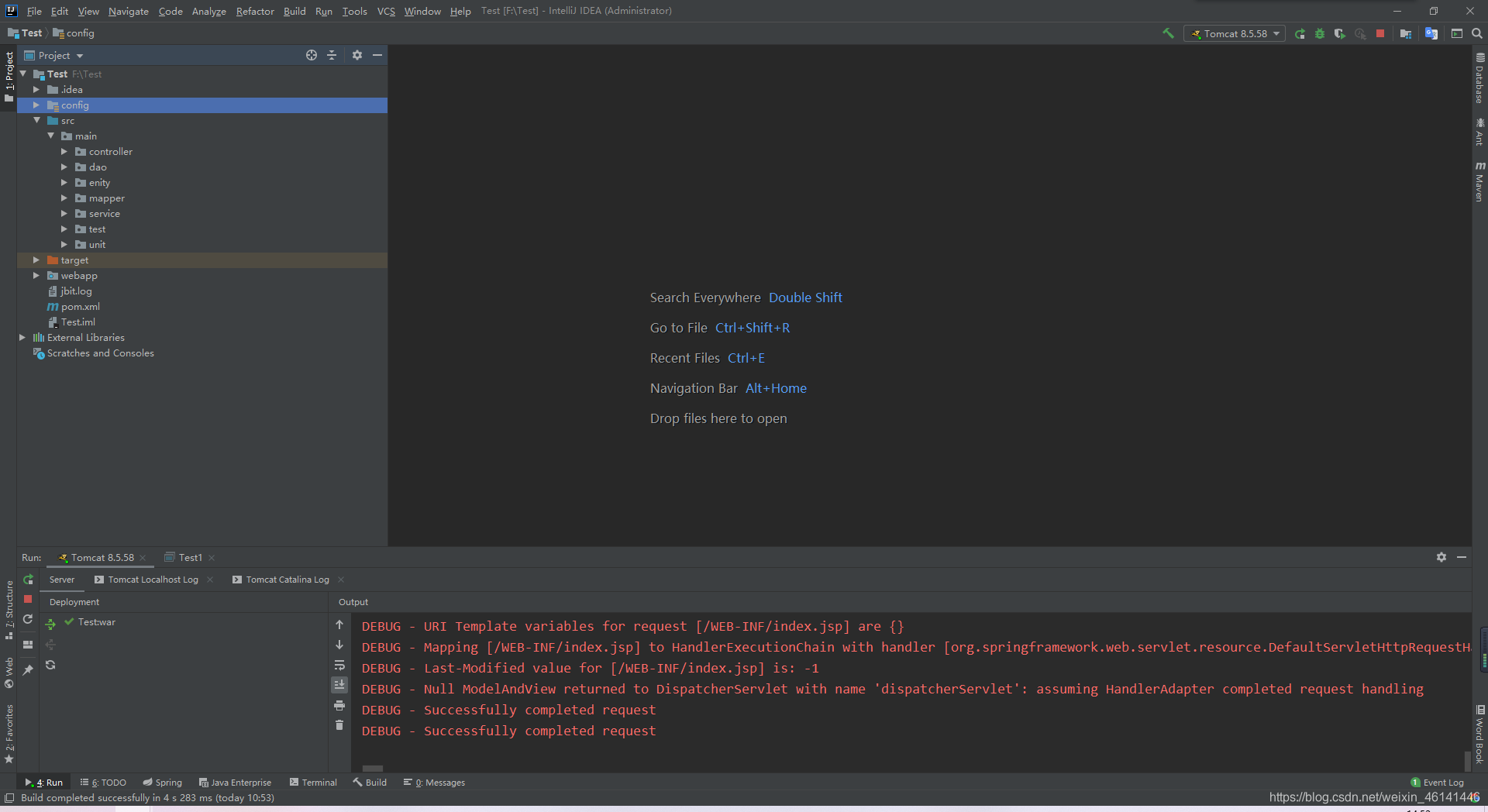首先,这个东西我找了好多文章,怕忘记,现在做出总结
- 我们先搭建一个Spring MVC项目
- 我用的是IDEA工具,搭建的时候使用的是Maven框架,就是我选中这个

下一步就好了,第一个是名字,第二个是存放的路径

- 新建完,就开始搭建项目结构
- Spring MVC由Model、View、Controller 组成所以项目结构为

- 首先进来,是没有config这个文件夹的,这个用于存放,配置文件,数据库配置文件啊什么的,这个等会再说
- 我简历了项目结构,分别为:Controller,dao、enity(这个名字不知道拼对没)、mapper、service、test、unit
- Controller:控制器包这个包用来控制访问的视图以及参数的处理
- dao:数据库操作包,这个包是放接口的,用于数据库的操作
- enity:实体类包,所谓一个表对应一个类,我觉得可以灵活使用不要拘泥。
- mapper:数据库映射文件,每个文件对应一个接口,数据库的操作语句就是在这写的。
- service:业务层,执行业务逻辑的地方。
- test:测试包,用于测试语句是否正常,有人用单元测试,我比较喜欢写测试包,舒服。
- unit:用于存放工具类的地方,工具!
- 现在说一下config包,这个包用于存放资源文件,我起名是这个,你们喜欢就用cfig都行,随意。
- 我一般放在项目的最外层,当然创建包它还要识别你的文件夹是不是资源文件夹,这个要你自己说。
- 怎么说,有两种方法
- 第一种右键文件夹的方式第三个就是了。

- 第二种


- 就是这样
- 然后进来的时候src,还不是蓝色的,也要相同的操作
- 关键点:webapp也要标记

- 项目报错建议来找不同
- 接下来说config里放了啥,多数据源开始了,注意看,这个是数据库配置信息文件,我配了两个数据源信息

- 开始写文件了,首先配置数据库信息获取
<?xml version="1.0" encoding="UTF-8"?>
<beans xmlns="http://www.springframework.org/schema/beans"
xmlns:xsi="http://www.w3.org/2001/XMLSchema-instance" xmlns:context="http://www.springframework.org/schema/context"
xmlns:jdbc="http://www.springframework.org/schema/jdbc" xmlns:jee="http://www.springframework.org/schema/jee"
xmlns:tx="http://www.springframework.org/schema/tx" xmlns:aop="http://www.springframework.org/schema/aop"
xmlns:mvc="http://www.springframework.org/schema/mvc" xmlns:util="http://www.springframework.org/schema/util"
xsi:schemaLocation="
http://www.springframework.org/schema/beans http://www.springframework.org/schema/beans/spring-beans-3.2.xsd
http://www.springframework.org/schema/context http://www.springframework.org/schema/context/spring-context-3.2.xsd
http://www.springframework.org/schema/jdbc http://www.springframework.org/schema/jdbc/spring-jdbc-3.2.xsd
http://www.springframework.org/schema/jee http://www.springframework.org/schema/jee/spring-jee-3.2.xsd
http://www.springframework.org/schema/tx http://www.springframework.org/schema/tx/spring-tx-3.2.xsd
http://www.springframework.org/schema/aop http://www.springframework.org/schema/aop/spring-aop-3.2.xsd
http://www.springframework.org/schema/mvc http://www.springframework.org/schema/mvc/spring-mvc-3.2.xsd
http://www.springframework.org/schema/util http://www.springframework.org/schema/util/spring-util-3.2.xsd">
<util:properties id="db" location="classpath:jdbc.properties" />
<bean id="dataSourceA" class="org.apache.commons.dbcp.BasicDataSource" destroy-method="close">
<property name="driverClassName" value="#{db.jdbcdriver}" />
<property name="url" value="#{db.jdbcurl}" />
<property name="username" value="#{db.jdbcusername}" />
<property name="password" value="#{db.jdbcpassword}" />
</bean>
<bean id="dataSourceB" class="org.apache.commons.dbcp.BasicDataSource">
<property name="driverClassName" value="#{db.driver}" />
<property name="url" value="#{db.url}" />
<property name="username" value="#{db.username}" />
<property name="password" value="#{db.password}" />
</bean>
<bean id="dataSource" class="main.unit.DynamicDataSource">
<!-- 通过key-value的形式来关联数据源 -->
<property name="targetDataSources">
<map key-type="java.lang.String">
<entry value-ref="dataSourceA" key="dataSourceA"></entry>
<entry value-ref="dataSourceB" key="dataSourceB"></entry>
</map>
</property>
<property name="defaultTargetDataSource" ref="dataSourceA" >
</property>
</bean>
<bean id="sqlSessionFactory" class="org.mybatis.spring.SqlSessionFactoryBean">
<property name="dataSource" ref="dataSource"></property>
<property name="mapperLocations" value="classpath:main/mapper/*.xml"></property>
</bean>
<!-- 将持久层包中所有接口扫描注册成MapperFactoryBean对象 -->
<bean class="org.mybatis.spring.mapper.MapperScannerConfigurer">
<property name="basePackage" value="main.dao"></property>
</bean>
</beans>- 上面是数据源配置,properties文件的信息读取不会可以百度一下,我们配置好数据源就要用到工具类了,我在工具类包新建了一个工具类
- 我给的默认数据库是A
package main.unit;
import org.springframework.jdbc.datasource.lookup.AbstractRoutingDataSource;
public class DynamicDataSource extends AbstractRoutingDataSource {
public static final String SOURCE_A = "dataSourceA";
public static final String SOURCE_B = "dataSourceB";
private static final ThreadLocal<String> contextHolder = new ThreadLocal<String>();
public static void setCustomerType(String customerType) {
contextHolder.set(customerType);
}
public static String getCustomerType() {
return contextHolder.get();
}
public static void clearCustomerType() {
contextHolder.remove();
}
@Override
protected Object determineCurrentLookupKey() {
return getCustomerType();
}
}
- 这个类是继承于 AbstractRoutingDataSource类,感兴趣可以看看源码,不多。
- 定义的两个变量就是数据库的名称(自己取的,喜欢可以叫fwkt,张三都可以),不过后面的值可不能乱写
- 然后我们看到几个方法,最主要的是最后一个,不能少,determineCurrentLookupKey()这个方法是指定使用哪个数据库的
- 接着我们先测试一下,为了节省时间,我把用到的类都丢出来
package main.dao;
import main.enity.Recommendation;
import java.util.List;
public interface Testdao {
public List<Recommendation> find();
}- 实体类,其实查出来没有这么多
package main.enity;
public class Recommendation {
private int userid;
private String username;
private int eferencesid;
private String power;
private int buynum;
private double monery;
public Recommendation(int userid, String username, int eferencesid, String power, int buynum, double monery) {
this.userid = userid;
this.username = username;
this.eferencesid = eferencesid;
this.power = power;
this.buynum = buynum;
this.monery = monery;
}
public Recommendation() {
super();
}
public int getBuynum() {
return buynum;
}
public void setBuynum(int buynum) {
this.buynum = buynum;
}
public String getPower() {
return power;
}
public void setPower(String power) {
this.power = power;
}
public double getMonery() {
return monery;
}
public void setMonery(double monery) {
this.monery = monery;
}
public int getUserid() {
return userid;
}
public void setUserid(int userid) {
this.userid = userid;
}
public String getUsername() {
return username;
}
public void setUsername(String username) {
this.username = username;
}
public int getEferencesid() {
return eferencesid;
}
public void setEferencesid(int eferencesid) {
this.eferencesid = eferencesid;
}
@Override
public String toString() {
return "Recommendation{" +
"userid=" + userid +
", username='" + username + '\'' +
", eferencesid=" + eferencesid +
", power='" + power + '\'' +
", buynum=" + buynum +
", monery=" + monery +
'}';
}
}
- mapper文件,namespace="main.dao.Testdao",这个指定包名,表示使用哪个接口的方法,id是方法名,resultType是返回值类型(全称)
<?xml version="1.0" encoding="UTF-8"?>
<!DOCTYPE mapper
PUBLIC "-//ibatis.apache.org//DTD Mapper 3.0//EN"
"http://ibatis.apache.org/dtd/ibatis-3-mapper.dtd">
<mapper namespace="main.dao.Testdao">
<select id="find" resultType="main.enity.Recommendation">
select * from vbl_recommendation
</select>
</mapper>
- 这个是service的接口
package main.service.ImpI;
import main.enity.Recommendation;
import java.util.List;
public interface TestImpi {
public List<Recommendation> find();
}- service继承于他,使用,数据库接口,如下:
package main.service;
import main.dao.Testdao;
import main.enity.Recommendation;
import main.service.ImpI.TestImpi;
import main.unit.DynamicDataSource;
import org.springframework.beans.factory.annotation.Autowired;
import java.util.List;
public class testservice implements TestImpi {
@Autowired
private Testdao testdao;
@Override
public List<Recommendation> find() {
return testdao.find();
}
}- 测试类环节
import main.dao.Testdao;
import main.enity.Recommendation;
import main.unit.DynamicDataSource;
import org.apache.ibatis.session.SqlSession;
import org.apache.ibatis.session.SqlSessionFactory;
import org.springframework.context.support.AbstractApplicationContext;
import org.springframework.context.support.ClassPathXmlApplicationContext;
import java.math.BigDecimal;
import java.util.HashMap;
import java.util.List;
import java.util.Map;
public class Test1 {
public static void main(String[] args) {
AbstractApplicationContext ac = new ClassPathXmlApplicationContext("application-dao.xml");
SqlSessionFactory factory = ac.getBean("sqlSessionFactory", SqlSessionFactory.class);
//切换数据源的操作在这
DynamicDataSource.setCustomerType(DynamicDataSource.SOURCE_A);//直接使用
SqlSession ss = factory.openSession(true);
Testdao testdao = ss.getMapper(Testdao.class);
List<Recommendation> recommendations = testdao.find();
System.out.println(recommendations);
System.out.println("结束");
ac.close();
}
}- 运行结果,A数据库

- B数据库,成功!

- 还有一些文件,自己测后面的吧
- Controller文件
import main.dao.Testdao;
import main.enity.Recommendation;
import main.unit.DynamicDataSource;
import org.springframework.beans.factory.annotation.Autowired;
import org.springframework.stereotype.Controller;
import org.springframework.web.bind.annotation.RequestMapping;
import org.springframework.web.bind.annotation.ResponseBody;
import java.util.List;
@Controller
public class TestConller {
@Autowired
Testdao testdao;
@Autowired
DynamicDataSource dynamicDataSource;
@RequestMapping("ddd")
public String test(){
dynamicDataSource.setCustomerType(dynamicDataSource.SOURCE_A);
List<Recommendation> recommendations = testdao.find();
String string = recommendations.toString();
System.out.println("==============================");
System.out.println(string);
return "index";
}
}- service配置文件
<?xml version="1.0" encoding="UTF-8"?>
<beans xmlns="http://www.springframework.org/schema/beans"
xmlns:xsi="http://www.w3.org/2001/XMLSchema-instance" xmlns:context="http://www.springframework.org/schema/context"
xmlns:jdbc="http://www.springframework.org/schema/jdbc" xmlns:jee="http://www.springframework.org/schema/jee"
xmlns:tx="http://www.springframework.org/schema/tx" xmlns:aop="http://www.springframework.org/schema/aop"
xmlns:mvc="http://www.springframework.org/schema/mvc" xmlns:util="http://www.springframework.org/schema/util"
xsi:schemaLocation="
http://www.springframework.org/schema/beans http://www.springframework.org/schema/beans/spring-beans-3.2.xsd
http://www.springframework.org/schema/context http://www.springframework.org/schema/context/spring-context-3.2.xsd
http://www.springframework.org/schema/jdbc http://www.springframework.org/schema/jdbc/spring-jdbc-3.2.xsd
http://www.springframework.org/schema/jee http://www.springframework.org/schema/jee/spring-jee-3.2.xsd
http://www.springframework.org/schema/tx http://www.springframework.org/schema/tx/spring-tx-3.2.xsd
http://www.springframework.org/schema/aop http://www.springframework.org/schema/aop/spring-aop-3.2.xsd
http://www.springframework.org/schema/mvc http://www.springframework.org/schema/mvc/spring-mvc-3.2.xsd
http://www.springframework.org/schema/util http://www.springframework.org/schema/util/spring-util-3.2.xsd">
<context:component-scan base-package="main.service"></context:component-scan>
</beans>- springMVC配置文件
<?xml version="1.0" encoding="UTF-8"?>
<beans xmlns="http://www.springframework.org/schema/beans"
xmlns:xsi="http://www.w3.org/2001/XMLSchema-instance" xmlns:context="http://www.springframework.org/schema/context"
xmlns:jdbc="http://www.springframework.org/schema/jdbc" xmlns:jee="http://www.springframework.org/schema/jee"
xmlns:tx="http://www.springframework.org/schema/tx" xmlns:aop="http://www.springframework.org/schema/aop"
xmlns:mvc="http://www.springframework.org/schema/mvc" xmlns:util="http://www.springframework.org/schema/util"
xsi:schemaLocation="
http://www.springframework.org/schema/beans http://www.springframework.org/schema/beans/spring-beans-3.2.xsd
http://www.springframework.org/schema/context http://www.springframework.org/schema/context/spring-context-3.2.xsd
http://www.springframework.org/schema/jdbc http://www.springframework.org/schema/jdbc/spring-jdbc-3.2.xsd
http://www.springframework.org/schema/jee http://www.springframework.org/schema/jee/spring-jee-3.2.xsd
http://www.springframework.org/schema/tx http://www.springframework.org/schema/tx/spring-tx-3.2.xsd
http://www.springframework.org/schema/aop http://www.springframework.org/schema/aop/spring-aop-3.2.xsd
http://www.springframework.org/schema/mvc http://www.springframework.org/schema/mvc/spring-mvc-3.2.xsd
http://www.springframework.org/schema/util http://www.springframework.org/schema/util/spring-util-3.2.xsd">
<!-- 扫描包 -->
<context:component-scan base-package="main.controller"></context:component-scan>
<!-- 配置视图解析器 -->
<bean id="viewResolver"
class="org.springframework.web.servlet.view.InternalResourceViewResolver">
<!-- /WEB-INF/index.jsp -->
<property name="prefix" value="/WEB-INF/"></property>
<property name="suffix" value=".jsp"></property>
</bean>
<!-- 处理静态资源 -->
<mvc:annotation-driven />
<mvc:default-servlet-handler />
</beans>
- web.xml配置文件
<?xml version="1.0" encoding="UTF-8"?>
<web-app xmlns:xsi="http://www.w3.org/2001/XMLSchema-instance"
xmlns="http://java.sun.com/xml/ns/javaee"
xsi:schemaLocation="http://java.sun.com/xml/ns/javaee http://java.sun.com/xml/ns/javaee/web-app_3_0.xsd"
id="WebApp_ID" version="3.0">
<display-name>Test Maven Webapp</display-name>
<servlet>
<servlet-name>dispatcherServlet</servlet-name>
<servlet-class>org.springframework.web.servlet.DispatcherServlet</servlet-class>
<init-param>
<param-name>contextConfigLocation</param-name>
<param-value>classpath:springmvc.xml</param-value>
</init-param>
</servlet>
<servlet-mapping>
<servlet-name>dispatcherServlet</servlet-name>
<url-pattern>/*</url-pattern>
</servlet-mapping>
<!-- 编码过滤器 -->
<filter>
<filter-name>characterEncodingFilter</filter-name>
<filter-class>org.springframework.web.filter.CharacterEncodingFilter</filter-class>
<init-param>
<param-name>encoding</param-name>
<param-value>utf-8</param-value>
</init-param>
</filter>
<filter-mapping>
<filter-name>characterEncodingFilter</filter-name>
<url-pattern>/*</url-pattern>
</filter-mapping>
<listener>
<listener-class>org.springframework.web.context.ContextLoaderListener</listener-class>
</listener>
<context-param>
<param-name>contextConfigLocation</param-name>
<param-value>classpath:application-*.xml</param-value>
</context-param>
</web-app>- 最后,提醒一下各位,不要忘记导包

- 我只是用到了几个包,看自己需要导,有人说,我没有怎么办,不急,用这个

- 示范
<dependencies>
<dependency>
<groupId>junit</groupId>
<artifactId>junit</artifactId>
<version>4.11</version>
<scope>test</scope>
</dependency>
<dependency>
<groupId>commons-beanutils</groupId>
<artifactId>commons-beanutils</artifactId>
<version>1.9.3</version>
</dependency>
<dependency>
<groupId>commons-collections</groupId>
<artifactId>commons-collections</artifactId>
<version>3.2.1</version>
</dependency>
<dependency>
<groupId>commons-lang</groupId>
<artifactId>commons-lang</artifactId>
<version>2.6</version>
</dependency>
<dependency>
<groupId>commons-logging</groupId>
<artifactId>commons-logging</artifactId>
<version>1.1.1</version>
</dependency>
<dependency>
<groupId>net.sf.ezmorph</groupId>
<artifactId>ezmorph</artifactId>
<version>1.0.6</version>
</dependency>
<dependency>
<groupId>net.sf.json-lib</groupId>
<artifactId>json-lib</artifactId>
<version>2.2.3</version>
<classifier>jdk15</classifier>
</dependency>
</dependencies>我的第一篇文章就这么结束了,希望我以后还记得




















 295
295











 被折叠的 条评论
为什么被折叠?
被折叠的 条评论
为什么被折叠?








